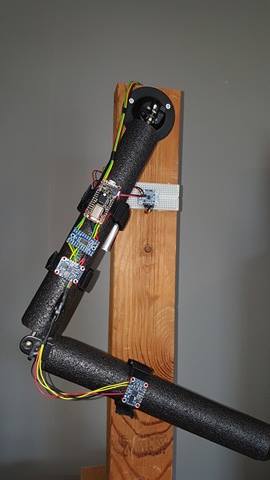Assistive Technologies Shirt Instrumentation
The goal of this project is to develop and implement data storage procedures, processing algorithms, and a visualization displays in order to present a useful summary of mobility between session to a therapist.
| Wearable remote monitoring | |
|---|---|
| Sponsor | Dr. Perry |
| Mentors | Bruce Bolden & Rick Sheldon |
| Team Name | Wearable-RM |
| Duration | Spring 2017 - Fall 2017 |
Problem Definition[edit | edit source]
Individuals recovering from post-stroke arm impairments spend significantly more time conducting therapeutic exercise at home without therapist supervision than they spend doing supervised therapy in a clinical setting. It is difficult to quantify the amount and quality of arm usage that takes place between supervised therapy sessions, which would be useful to know both as an indicator of functional recovery, and also as a way to monitor activity level and its impact on motor recovery.
Background[edit | edit source]
This purpose of this project is to implement a range of motion monitoring garment using absolute orientation sensors with a focus in rehabilitation applications. Currently there does not exist a low cost, wearable solution for the need of in home rehabilitation monitoring for impaired patients. Absolute orientation sensors are placed on the upper arm, lower arm, and upper torso which enables the derivation of shoulder and elbow mobility. The data from the three sensors are acquired and transmitted to a mobile device using an Adafruit Feather Bluetooth low energy microcontroller. The device is powered by a 3.7 2000 mAh lithium polymer battery selected for an effective wireless running time of ~72 hours. The resulting device is an accurate, repeatable, and potentially low cost alternative to other devices currently used in rehabilitation applications.
Specifications[edit | edit source]
A. Sensor Selection[edit | edit source]
Several metrics were used in the selection of sensors. The technology needed to possess the following qualities: low- profile, affordable, easily configurable, consume low amounts of energy, accurate, high measurement repeatability, and washable.
B. Data Acquisition[edit | edit source]
The method for obtaining empirical results from the garment was carefully considered. It was determined that the data acquisition should be performed by a device that was portable, lightweight, uninstructive to the user, and required low power consumption.
C. Power Delivery[edit | edit source]
To maintain the low-profile, portable aspect of the garment, a detachable battery source was needed. Adafruit provides a 3.7 V lithium ion polymer battery capable of supplying the necessary power required by the system for a theoretical continuous operating time of ~72 hours. The battery is rechargeable via a micro USB cord.
D. Sensor Mounting[edit | edit source]
The attachment of the sensors to the garment were vital for the operation and overall success of the prototype.The sensor was attached via elastic bands. This implies that to obtain repeatable results, the bend itself must be repeatable.
Project Learning[edit | edit source]
Adafruit Feather BLE[edit | edit source]
Used to transmit sensor data to the Android application.
Adafruit BNO055[edit | edit source]
Used to determine absolute orientation and transmits data to the Feather BLE.
Multiplexer[edit | edit source]
Allows us to connect multiple BN055 to the single Feather BLE.
Arduino IDE[edit | edit source]
Used to program the Feather BLE.
Android studio[edit | edit source]
Used to develop the Android application.
Team Information[edit | edit source]
From left to right:
| Member | Biography | Discipline |
| Abdullah Aldoussari | Abdullah Aldoussari is a senior in electrical engineering. He started his degree in the Fall 2014 and he emphasis in power. Also, He enjoys playing soccer and watching TV in his free time. | Electrical Engineering |
| Colton Hotchkiss | Colton Hotchkiss is senior Computer Science student. He hopes to translate his love of computer and technology into a career in network administration or cyber security. After high school, Colton joined the U.S. Navy where he served as a Electronics Technician on the U.S.S. Cheyenne Submarine in Hawaii. Colton is married to his wife, Jessica, and most of their time is spent entertaining their two dogs. Colton spends his spare time playing League of Legends and begging his wife to buy things on Amazon.. | Computer Science
|
| Yazeed Alotaibi | Yazeed Alotaibi is an International student from Saudi Arabia. He is a senior in electrical engineering.I am a bilingual in Arabic and English. I like to do many things in my free time such as meeting new people, learning something new from different culture, and playing soccer, volleyball, traveling, horse riding and swimming.. | Electrical Engineering |
| Genaro Martinez | I am majoring in Computer Engineering. I was born in Burley Idaho and I enjoy playing video PVP.. | Computer Engineering |

